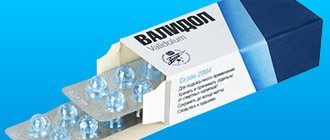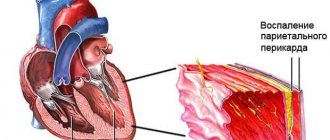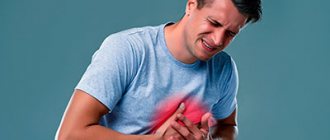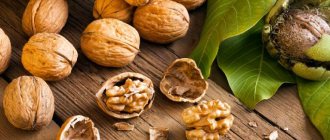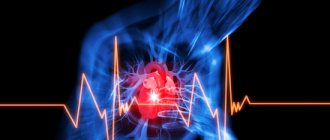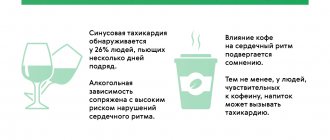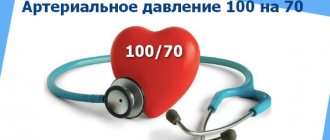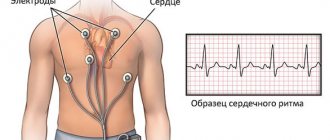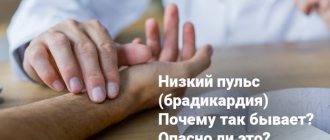A rapid heartbeat of 100 beats per minute attracts the attention of doctors, since it exceeds the norm, which for a healthy adult is 60-80 beats. It is considered absolutely normal for a person without heart pathologies if he does not feel his heartbeat. Increased heart rate during arrhythmia is called tachycardia; this condition requires normalization.
Causes of rapid heartbeat
If a person is at rest, then it is considered normal when he does not feel his own heartbeat. Tachycardia (increased heart rate above 100 beats per minute) can occur in healthy people under the following circumstances:
- strong emotional experiences;
- increased physical activity;
- changes in environmental parameters - lack of oxygen in the air;
- fever - with an increase in body temperature by 1 degree, the heartbeat increases by an average of 10 beats/minute.
In such situations, tachycardia does not indicate the presence of heart disease, but is a normal physiological reaction of the body.
The presence of physiological tachycardia is noted when hormonal levels change - in women during menopause. Sometimes the heart begins to beat faster due to an allergic reaction or after eating a large meal. Eating foods rich in caffeine is another cause of tachycardia.
The key feature of physiological tachycardia is the absence of accompanying symptoms:
- increased blood pressure;
- burning or pain in the heart area;
- dizziness and darkening of the eyes;
- fainting state;
- panic attack.
When the heart rate increases due to external factors, normalization of the heart rate occurs within a few minutes - for this it is enough to assume a state of rest.
During active physical activity, you should monitor your own pulse and be able to calculate the maximum heart rate. To do this, you need to subtract your own age from the number 220. So, for a 40-year-old person during sports training, the pulse should not exceed 180 beats per minute.
For a person leading a sedentary lifestyle, any physical effort (change of body position, sudden standing up) can cause an attack of tachycardia. In such cases, you can get rid of increased heart rate only through gradual and feasible training.
Is it possible to quickly stop a heart attack?
To quickly deal with palpitations, you can use two simple recommendations:
- Immerse your face in cold water.
The heart begins to beat less frequently as the body cools down. This is an effective method that is accessible to most people. If you don’t have a container on hand to collect liquid, you can simply rinse your face with cool water or wipe it with pieces of ice.
- Perform the Valsalva maneuver.
The person will need to take a deep breath and tense their abdominal muscles. The nose is pinched with two fingers, the mouth and eyes are closed. In this state, you need to try to exhale. At the same time, the abdominal muscles are tensed.
All these methods can be used in cases where increased heart rate was caused by physiological factors. If chest pain appears during an attack and shortness of breath develops, you should seek help from a doctor.
Author of the article:
Molchanov Sergey Nikolaevich |
Cardiologist Education: Diploma in Cardiology received from Perm State Medical University named after. I. M. Sechenova (2015). Here I completed my postgraduate studies and received a diploma in Cardiology. Our authors
Tachycardia as a symptom of the disease
Tachycardia at normal pressure can be caused by:
- obesity;
- diabetes;
- diseases of the stomach, thyroid gland.
The causes of tachycardia in women of physiological type are observed during menopause, with hormonal changes in the body and a decrease in estrogen levels. Estrogen stimulates the autonomic nervous system, affects the intestines, breathing, and heartbeat. For this reason, during menopause, when the concentration of estrogen decreases, the following symptoms of tachycardia occur in women:
- dizzy;
- shortness of breath appears;
- hot flashes occur;
- feeling of pulsation and fluttering in the chest.
The cause of the pathological disease is cardiac, vascular problems, disruptions in the functioning of other systems. The main extracardiac factors include:
- psoriasis;
- dehydration of the body;
- blood loss;
- temperature during a sore throat.
Often, when the disease is tachycardia, the causes may be pain syndromes of various origins and an increase in temperature. Frequent heartbeat can be observed in most heart and vascular diseases.
- Heart attack.
- Myocarditis, pericarditis.
- Heart defects.
In the case of idiopathic increased heart rate, it is impossible to determine the obvious factors of the disturbed rhythm. Therefore, if there is a rapid heartbeat, having eliminated the causes, treatment will be aimed at combating the disease.
Is there a connection between pulse and blood pressure?
In any critical situation, in order to assess the severity of a person’s condition, I primarily focus on blood pressure and pulse numbers.
Blood pressure and pulse are closely related. Thanks to their regulation, normal blood supply to all internal organs is ensured.
In a physiological sense, the pulse always “adjusts” to the pressure value. For example, when blood pressure decreases, the heart rate increases compensatoryly to maintain blood circulation at the proper level.
However, if the pulse is too fast (pathological), the diastole time (the phase of the cardiac cycle during which the chambers of the heart fill with blood) decreases. As a result, when the ventricles contract, less blood is released into the systemic circulation, which leads to a decrease in blood pressure and a deterioration in general circulation.
How to diagnose tachycardia
With sinus tachycardia, when the increase in contractions of the heart muscle is associated only with external factors, a special examination, as a rule, is not required. But in cases where the increase in the number of heartbeats is not a consequence of stress or increased physical activity, it is necessary to undergo a number of manipulations to help diagnose tachycardia:
- electrocardiogram (ECG) - to determine the level and rhythm of contractions of the heart muscle at the time of the study;
- 24-hour Holter monitoring – helps to find out how the heart rate changes over a 24-hour period during physical activity, with low mobility and during sleep;
- Ultrasound examination of the heart, echocardiography – detects pathological abnormalities in the functioning of the heart.
Blood pressure must be measured; in addition, bicycle ergometry may be prescribed (hardware monitoring of the performance of the cardiac system during exercise on an exercise bike).
Rapid heartbeat can be caused not only by cardiac pathology, but also by other diseases of the internal organs. Therefore, in addition to specialized studies, it is advisable to take blood tests (biochemistry, electrolyte content, thyroid hormones) and urine.
Diagnostics
Measures to eliminate the increase in heart rate should be taken immediately when symptoms are detected. Before prescribing treatment, the doctor will conduct a detailed examination, collect anamnesis, and find out whether any of the patient’s family members suffered from cardiovascular pathologies. To determine why the pulse fluctuates despite normal blood pressure readings, a comprehensive diagnosis is needed.
The recommended list of examinations includes:
- general blood tests and for biochemical composition - here signs of chronic inflammation in the body, lack of hemoglobin and other problems may appear;
- ECG – to assess the functioning of the heart;
- taking blood for analysis of hormone levels - allows you to identify incipient diseases of the endocrine system;
- daily monitoring of blood pressure and heart rate to record the time of increase in pulse and the conditions predisposing to it;
- Ultrasound of the heart;
- Ultrasound of the abdominal organs, liver, kidneys.
Performing an ultrasound of the heart
If consultation with additional specialists is required, the patient is referred to a neurologist, endocrinologist, or ENT doctor, depending on the root cause of the signs of arrhythmia.
First aid for an attack
The first step is to create maximum rest conditions for the patient (half-sitting or lying down), unbutton his clothes to ensure a flow of fresh air. It should be noted that those around the patient should express calm and not cause panic. A person having an attack should take a deep breath and hold it, and then exhale slowly.
By performing such breathing exercises, the attack can be stopped. Emergency care for tachycardia can be as follows: changing the patient’s body position from horizontal to vertical and vice versa, straining for 50 seconds, inducing a gag reflex, Usher’s test (pressure on the eyeballs).
It should be noted that pressing on the eyeballs is not recommended if emergency care is provided for paroxysmal tachycardia in children, as this action may result in retinal detachment. If the first emergency aid for an attack of tachycardia does not work, drug methods should be used.
Take sedatives: 40-50 drops of valocardine, motherwort or valerian preparations and others (thus, emergency assistance can be provided for sinus tachycardia). When emergency care is provided for tachycardia, you must immediately call an ambulance.
Emergency care for ventricular tachycardia should be provided by qualified specialists, as it involves administering intravenous injections. Injections are given with antiarrhythmic drugs, cardiac glycosides, and sometimes electrical pulse therapy can be used.
Emergency care for supraventricular tachycardia with a medical approach is very quickly eliminated by using antiarrhythmic drugs (as a rule, the patient himself can know which drug will help him), but you can try to cope on your own without using serious medications.
It is necessary to distinguish the norm from the disease
If a person regularly sees a blood pressure of 120/100 during measurement, he should visit a cardiologist. Despite a slight deviation in the normal pulse pressure, this is a demonstration of the onset of pathological changes in the condition of the heart and blood vessels. A constant departure of the lower indicator beyond normal limits, while the upper one remains unchanged, indicates the possible presence of the following problems:
Why does blood pressure jump during menopause?
- sclerotic changes in the capillary system;
- diseases of the renal system;
- hormonal imbalances;
- diseases of the spinal column;
- elevated blood sugar levels;
- problems with the thyroid gland.
Blood pressure of 125/100 and even 130/100 should not frighten a person if it appears once after hard physical work, as a result of stress or mental overstrain. Therefore, in such a situation, it is important to separate a single jump in tonometer readings from the first signs of a developing disease. It is not possible to do this on your own; if your diastolic pressure constantly increases, you should consult a specialist and undergo an examination.
How to reduce heart rate?
When the pulse quickens for no apparent reason, it causes fear and anxiety. The main thing in such a situation is not to be nervous and try to determine what is happening in the body. If tachycardia remains the only symptom, you should breathe deeply and remain calm. Warning signs may include pain in the heart area that radiates to the neck or arm, as well as numbness and trembling of the limbs. In most cases, they are absent, and you can calm your heartbeat at home quickly, thanks to several useful methods.
In many home medicine cabinets you can find drugs to reduce heart rate. They are available without a doctor's prescription and will help you quickly restore your performance. However, before taking them, it is important to find out the cause of this symptom, since different groups of drugs have different compositions and are indicated for tachycardia of different origins. So, the doctor may recommend the following medications:
- Valocordin, Corvalol
- drugs based on phenobarbital and plant extracts, available in the form of drops that need to be diluted in water; - valerian officinalis
- comes in the form of drops and tablets, it helps well with tachycardia caused by nervous tension; - rosehip or hawthorn fruits, motherwort root
- raw materials for the preparation of soothing decoctions, useful for calming the heartbeat; - if necessary
, medications to replenish potassium or magnesium deficiency (Asparkam, Panangin).
After taking medications, you should avoid physical activity. It is better to spend this day in a calm environment, avoiding stress and nervous tension.
Video - Rapid heartbeat. How to calm your heart
What pressure is considered normal?
A person’s blood pressure has two indicators - the upper (systolic), recorded at the moment the heart contracts, and the lower (diastolic), noted when the heart relaxes and pushes blood into the arteries. When the heart and capillaries are functioning normally, the tonometer readings are within 120/80 or 110/70; a slight deviation up or down is not considered a pathology.
For each person, the pressure is individual, but, in addition to fixing the two indicators, it is necessary to monitor the difference between them. This difference is called pulse pressure and can also indicate existing health problems. Changes in tonometer readings are affected by:
- Times of Day;
- nervous tension, stress;
- physical exercise;
- binge eating;
- alcohol consumption;
- taking certain medications.
If, after an unexpected increase in blood pressure (BP) levels, the indicators stabilize on their own, and the fact of jumps is rarely observed, there is nothing to worry about. The normal difference between the upper and lower limits should be from 35 to 55 mmHg, and a regular decrease in this indicator indicates the development of cardiovascular pathology.
What does the heart need?
Of all the chemical elements, the heart needs most:
- iodine (products containing it have a beneficial effect on metabolism: these are sea fish, squid, shrimp, seaweed and other gifts of Neptune),
- potassium (it improves the activity of the heart muscle, promotes the removal of excess fluid: most of it is found in potatoes, pumpkin, cabbage, apricots, prunes, dried apricots, figs, rose hips, black and red currants, parsley),
- magnesium (this element has a calming, vasodilating and diuretic effect, maintains the tone of the walls of blood vessels, and therefore do not neglect porridges: oatmeal, millet, barley, buckwheat, as well as walnuts, peas, beets, carrots, salad; wheat bran is rich in magnesium, soy flour, sweet almonds, bananas.American scientists have concluded that those who receive at least half a gram of magnesium daily (that’s how much it is contained in one banana) have a minimal risk of heart attack).
And another gastronomic addiction of your heart is dairy and vegetarian soups: from cereals, vegetables. Do you remember the last time these dishes were on your table?
Diagnostic and treatment options if pulse is more than 100
In order to detect the cause of a constant pulse of more than 100 beats per minute, you need to undergo an examination:
- ECG (standard, with stress, 24-hour Holter monitoring);
- echocardiography, if the results are questionable, an MRI is performed;
- electrophysiological study of the heart for complex rhythm disturbances;
- blood test, if necessary, for hormones and electrolytes;
- electroencephalography.
Based on the results of the examination, a treatment method can be chosen: medications for tachycardia, psychotherapy, sedatives, including folk remedies, the use of hormones, iron supplements and other options.
Medicines
To slow down the rhythm associated with stress and endocrine disorders, drugs from the group of beta-blockers (Anaprilin, Metoprolol) are used. If they are contraindicated, then calcium antagonists (Verapamil, Diacordin) are used.
For neurosis, herbal sedatives can be prescribed: tincture of peony, motherwort, Novo-passit, Persen, dietary supplements - Evening dragee, Motherwort forte. To improve cardiac activity, Riboxin and Panangin are recommended.
Traditional methods
With a pulse of 100-120, you can undergo a course of treatment with herbal remedies, but after serious heart diseases are excluded, that is, specific drug therapy is not required. To prepare an infusion of 300 ml of boiling water, take a tablespoon of one of the herbs:
- lavender flowers,
- lemon balm grass,
- mint leaves,
- hawthorn berries and flowers,
- motherwort grass,
- hop cones.
After infusion for 30 minutes, filter the infusion and take 100 ml half an hour before meals for a month in a warm form. If you are not intolerant, you need to add a teaspoon of honey.
Physiotherapy
With tachycardia and pulse 100 against the background of neurocirculatory dystonia, non-drug methods are more helpful:
- electrosleep;
- magnesium electrophoresis on the collar area;
- general and acupressure massage;
- baths with pine needle extract, valerian, sage or lavender oil.
Traditional medicine to normalize heart rate
Along with medications, traditional medicine recipes can also prevent increased heart rate. Most often, medicinal plants are used in the treatment of tachycardia, which contain natural glycosides and herbs with a calming effect.
| Product name | Ingredients and preparation | Mode of application |
| Viburnum and cranberry balm | Viburnum and hawthorn (berries) - 1 kg each. Rose hips, cranberries - 0.5 kg each. Place in layers in a 5-liter container, sprinkle with sugar (you can use honey). Pour vodka to the level of the berries. Leave in a dark place for 21 days | 30 g twice a day - morning and evening. You can use berries from balsam to make compotes |
| Oriental Heart Balm | Lemon (with peel) – 500 grams. Dried apricots, raisins – 500 grams each. Walnuts (kernels) – 500 grams. Grind using a blender, add 1 kg of honey. Store in a cool place | 1 teaspoon per day in the morning |
| Clover tincture | Place fresh clover flowers in a container (liter jar) and fill with vodka. Infusion time: 30 days in a dark place | 1 teaspoon three times a day, after meals |
Take a medium sized head of garlic and make a paste from it. We put everything in a jar, fill it with unrefined sunflower oil and leave it at home inside the refrigerator for the whole next night. In the morning, cut out the top of a ripe lemon with a knife and squeeze fresh juice into a teaspoon. Let's add a little garlic oil.
We make butter this way. Peel 2 garlic heads and cut them into small pieces. Place in a jar made of any glass and fill with vegetable oil (about half a glass). We store the jar in the sun for 11 days, stirring it every day. After 11 days, filter and add 1 drop of purified glycerin (sold at the pharmacy). Let's put everything into a bottle, but now from darkish-colored glass with a good cork. It belongs in the refrigerator. Treatment at least three times in one day. The course is usually allowed for up to 90 days.
Reasons why there is a heart rate of 100 at rest
The resting heart rate increases to 100 per minute due to cardiac and non-cardiac causes. The first group includes:
- chronic and acute heart failure (weakness of heart contractions with blood stagnation);
- myocardial infarction and pre-infarction condition, unstable angina;
- inflammatory process – myocarditis, rheumatic carditis, endocarditis, pericarditis;
- non-inflammatory heart damage - cardiomyopathy (including menopause, hypertension, hormonal imbalance, alcoholism);
- heart defects.
Among non-cardiac causes, the leading position is occupied by neurosis and neurocirculatory dystonia; young people are most often susceptible to them. In second place are hormonal diseases: thyrotoxicosis (increased thyroid function), increased production of adrenal hormones.
Other risk factors:
- anemia;
- lack of oxygen due to lung diseases;
- vascular insufficiency - fainting, collapse, shock;
- painful attacks;
- infection with fever;
- use of drugs: vasoconstrictor nasal drops, Adrenaline, Salbutamol, Atropine, Eufillin, hormones, thyroxine, diuretics, to reduce blood pressure;
- abrupt withdrawal of medications for tachycardia.
Prevention of tachycardia
The best method for preventing tachycardia is to reduce the risk of developing one of the many heart diseases. It is often because of them that irregularities in the heart rhythm appear. To avoid illness, you should constantly monitor your indicators - this will help you notice any deviations in a timely manner and eliminate the problem at an early stage. To reduce the risk of tachycardia, it is recommended to take simple measures of the following nature:
- Regularly engage in physical training to the best of your ability;
- Lead a healthy lifestyle, including a healthy diet with enough fruits, whole grains and vegetables;
- Limit consumption of fatty foods and quit alcohol, drugs and smoking;
- Maintain body weight in the optimal range for your gender, age, weight and professional activity;
- Control blood cholesterol levels;
- Reduce your consumption of coffee and caffeinated drinks to a minimum.
It is also important to use any medications with great caution. From a young age you need to monitor the normalization of blood pressure, and especially in old age. It is necessary to try to avoid psychological stress. Regular visits to the doctor will help you take preventive measures in a timely manner and prevent the development of tachycardia.
You should be aware that caffeine can have an extremely negative effect on your heart rhythm and lead to arrhythmic conditions. It is impossible to say unequivocally what excessive caffeine consumption is, since it is very individual for each person. For some, a cup of coffee a day will not do any harm, but for others, even one cup a week may do a disservice.
Assisted therapy at home
You cannot treat palpitations on your own. However, if a person is predisposed to such attacks, you need to be able to help yourself.
In addition to taking medications, you can use the following recommendations:
- Lead a measured lifestyle.
- Avoid stress and allocate enough time for rest.
- Do physical therapy.
- Do exercises every morning.
- Eat right, avoid fatty foods, do not drink tea, carbonated water, coffee, chocolate.
- Take a contrast shower and soak your feet.
- Bring your body weight back to normal.
- Take vitamins.
If a person is prone to increased heart rate, which occurs like attacks, it is necessary to avoid excessive physical exertion. They can lead to the formation of blood clots.
Diet is an integral component of treatment. Every day a person should eat fortified foods: vegetables, fruits, dried fruits, nuts. Be sure to include dried apricots, fresh watermelons, potatoes, currants, beets, raspberries, and citrus fruits in your diet.
After medical consultation, it is permissible to take magnesium supplements. In case of a sudden attack, you should lightly massage the right side of the neck, in the place where the carotid artery passes. This will prevent heart palpitations and prevent a crisis.
What are the future risks of a high pulse?
If you do not notice in time and do not contact pediatric cardiology in Saratov for adequate treatment, the child will experience frequent painful sensations over time, and in addition, he may develop associated disorders:
- with vessels, veins and arteries;
- with the nervous system;
- with hormonal background.
A pediatric cardiologist in Saratov, based on the monitoring results and tests obtained, will determine and make an accurate diagnosis, which will allow you to prescribe treatment, the effectiveness of which will not be long in coming. It is also important to record changes after a certain time in order to adjust the medication course and prescribe additional physiotherapeutic procedures, and choose the appropriate sport. It is important to take measurements immediately after physical activity of varying strength and intensity, after strong positive or negative psychological reactions. Pulse rate measurements after sleep are also important for a pediatric cardiologist in Saratov to determine the diagnosis and prescribe effective and appropriate treatment.
Over time, as the child grows up, it is necessary to teach him to monitor his pulse rate, especially after physical or emotional stress. There are drugs that can quickly restore the pulse rate, and in addition, maintenance therapy. Every year a little patient must learn to listen to his body, and an experienced pediatric cardiologist in Saratov will help with this.
Make an appointment with a cardiologist
Choose a doctor

